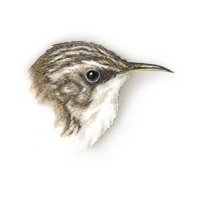|
Field
Guide IDs: BREEDING:
Pine forests (esp
ponderosa, yellow, Jeffrey). ? broods. DISPLAYS:
Courtship: male
display flights, chases, wing fluttering, and
courtship feeding; male spirals rapidly around tree
trunk in pursuit of female. NEST:
Hammocklike cup,
usu beneath loose bark, rarely in cavity; of bark,
moss, conif needles, silk, on base of twigs which
nearly close opening between bark and trunk, lined
with shredded bark, feathers. Pair select site.
Built in 6-30 days. EGGS:
White, sparsely
flecked with reddish-browns, often wreathed, occ
almost unmarked. 0.6" (15 mm). DIET:
Includes spiders,
other invertebrates; some acorns, beechnuts. Young
may be fed 100% animal food. CONSERVATION:
n populations
winter s to Nicaragua, remainder within breeding
range. Rare cowbird host. NOTES:
Use camouflage
pattern when pursued: land on tree trunk, flatten,
spread wings and remain motionless. Normally feed
by ascending trunk in spiral or straight course,
then dropping to repeat on another trunk. Male
feeds incubating female. Female broods. Young can
creep upward as soon as mobile. Fledglings roost in
tight circle, heads to center. Fairly rare to
uncommon migrant and winter resident in a variety
of habitats throughout campus. Not known to breed
on campus. ESSAYS: Bird
Guilds;
Mixed-Species
Flocking;
Communal
Roosting;
Temperature
Regulation;
The
Color of Birds;
Courtship
Feeding REFERENCES:
Davis, 1978;
Franzreb, 1985. |
